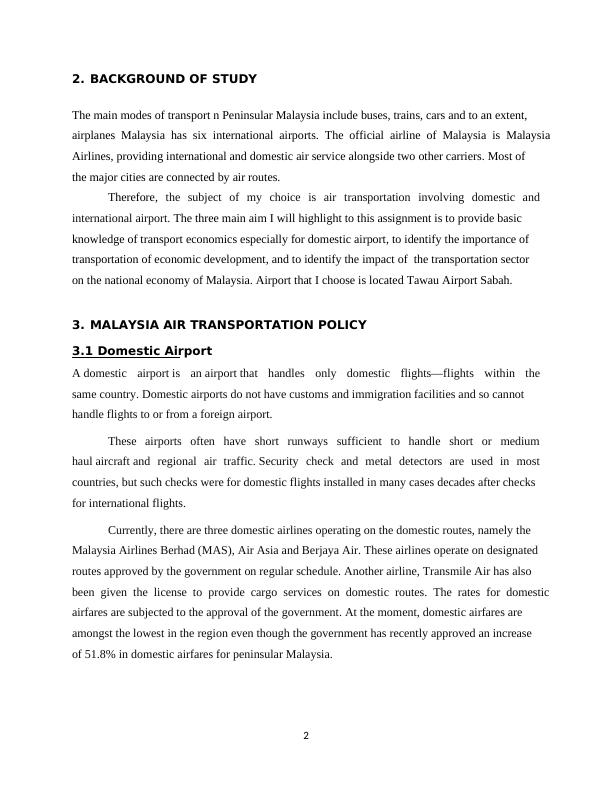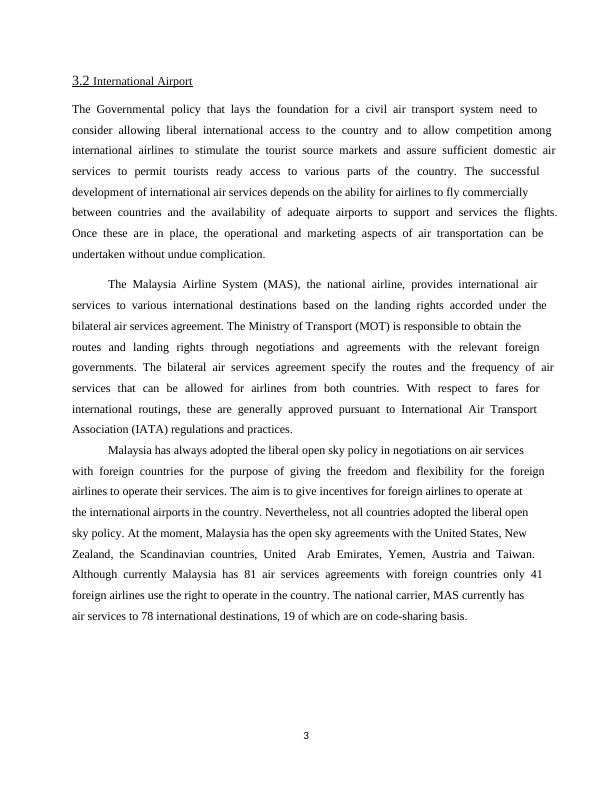Ask a question from expert
Role of the Transportation Sector in Economics PDF
12 Pages3179 Words47 Views
Added on 2020-11-30
Role of the Transportation Sector in Economics PDF
Added on 2020-11-30
BookmarkShareRelated Documents
1 1.INTRODUCTION Transportation is the most important and vital to the movement of both freight and passengers around the world. Without transportation system in every country the people can consider the activities in their life is not efficient. It is also have a benefits and role to the other industries in a national economy. The transportation network is not only important because it provides an economic base and employment, but also because it is a service that is utilized to some extent by most sectors in the economy Transportation can be define as any device used to move an item or services from one location to another. Commons forms of transportation include planes, trains, automobiles. But the specific in this study is on Land Transport, Water Transport, Air Transport, Port and Airport Operation Services, Highway, Bridge and Tunnel Operation Services and Communication also considered in transportation sector. Malaysia is a south-east Asian country and surrounding countries and water bodies of Malaysia. It covers an area of 329,750 sq km and a population of approximately 28.86 million in year 2011. Land and rail transport are responsible for providing domestic freight and passenger services, while water and air transportation which makes it essential for global business and tourism. It plays a vital role in facilitating economic growth, particularly in developing countries. The two main aim to this assignment is to provide basic knowledge of transport economics especially for domestic airport, and to identify the role and influence of the transportation sector on the national economy of Malaysia.

2 2.BACKGROUND OF STUDY The main modes of transport n Peninsular Malaysia include buses, trains, cars and to an extent, airplanes Malaysia has six international airports. The official airline of Malaysia is Malaysia Airlines, providing international and domestic air service alongside two other carriers. Most of the major cities are connected by air routes. Therefore, the subject of my choice is air transportation involving domestic and international airport. The three main aim I will highlight to this assignment is to provide basic knowledge of transport economics especially for domestic airport, to identify the importance of transportation of economic development, and to identify the impact of the transportation sector on the national economy of Malaysia. Airport that I choose is located Tawau Airport Sabah. 3.MALAYSIA AIR TRANSPORTATION POLICY 3.1 Domestic Airport A domestic airport is an airport that handles only domestic flights—flights within the same country. Domestic airports do not have customs and immigration facilities and so cannot handle flights to or from a foreign airport. These airports often have short runways sufficient to handle short or medium haul aircraft and regional air traffic. Security check and metal detectors are used in most countries, but such checks were for domestic flights installed in many cases decades after checks for international flights. Currently, there are three domestic airlines operating on the domestic routes, namely the Malaysia Airlines Berhad (MAS), Air Asia and Berjaya Air. These airlines operate on designated routes approved by the government on regular schedule. Another airline, Transmile Air has also been given the license to provide cargo services on domestic routes. The rates for domestic airfares are subjected to the approval of the government. At the moment, domestic airfares are amongst the lowest in the region even though the government has recently approved an increase of 51.8% in domestic airfares for peninsular Malaysia.

3 3.2 International Airport The Governmental policy that lays the foundation for a civil air transport system need to consider allowing liberal international access to the country and to allow competition among international airlines to stimulate the tourist source markets and assure sufficient domestic air services to permit tourists ready access to various parts of the country. The successful development of international air services depends on the ability for airlines to fly commercially between countries and the availability of adequate airports to support and services the flights. Once these are in place, the operational and marketing aspects of air transportation can be undertaken without undue complication. The Malaysia Airline System (MAS), the national airline, provides international air services to various international destinations based on the landing rights accorded under the bilateral air services agreement. The Ministry of Transport (MOT) is responsible to obtain the routes and landing rights through negotiations and agreements with the relevant foreign governments. The bilateral air services agreement specify the routes and the frequency of air services that can be allowed for airlines from both countries. With respect to fares for international routings, these are generally approved pursuant to International Air Transport Association (IATA) regulations and practices. Malaysia has always adopted the liberal open sky policy in negotiations on air services with foreign countries for the purpose of giving the freedom and flexibility for the foreign airlines to operate their services. The aim is to give incentives for foreign airlines to operate at the international airports in the country. Nevertheless, not all countries adopted the liberal open sky policy. At the moment, Malaysia has the open sky agreements with the United States, New Zealand, the Scandinavian countries, United Arab Emirates, Yemen, Austria and Taiwan. Although currently Malaysia has 81 air services agreements with foreign countries only 41 foreign airlines use the right to operate in the country. The national carrier, MAS currently has air services to 78 international destinations, 19 of which are on code-sharing basis.

4 4.MALAYSIA AIRPORT There are currently 5 international airports operating in the country, namely the Kuala Lumpur International Airport (KLIA), Penang, Kuching, Kota Kinabalu and Langkawi airports. All these airports are able to accommodate the largest commercial aircrafts currently in use. In addition, there are 17 domestic airports and 15 rural airstrips in the rural areas mainly in Sabah and Sarawak. Although the airports in Malaysia has been privatized and operated by the Malaysia Airports Holdings Berhad (MAHB), the government is still directly involved in the development and financing of the airports. There has been a gradual increase in number of passengers handled by all international airports in Malaysia since the early nineties till around 1997. A slight drop in passengers were observed in 1998 when the new Kuala Lumpur International Airport (KLIA) started operations in June 1998 and the then Subang International Airport began to cease most of its international flight operations. It may not have been very easy to maintain a smooth switch between Subang and KLIA since the two locations is quite some distance apart. In the beginning, the KLIA was meant to handle all international flights while the Subang airport still maintains the domestic flights. This may have been a factor that affects the passenger demand since direct connections are not available at either airport for those intending to change between international and domestic flights. Nevertheless, the total passengers handled by Malaysian airports began to rise in 1999 onwards especially when the KLIA began to receive greater patronage from foreign airlines. Despite the slowdown in air travel after the September 11, 2001 terror attacks in the US and the October 2002 bombing on the Indonesian resort island of Bali, there is a significant growth in passenger traffic at the KLIA.

End of preview
Want to access all the pages? Upload your documents or become a member.
Related Documents
Changi International Airport: Operations, Cargo Handling, and Enhancementslg...
|6
|1456
|464
Air Transportation Industry in Australia: Market Analysis and Competitive Landscapelg...
|8
|3081
|188
History of Aviation Industrylg...
|8
|2450
|185
BUSINESS TABLE OF CONTENTS INTRODUCTION 1: Business Overview, SWOT and PESTLE Analysislg...
|13
|3899
|462
Malaysia Airlines Change Management - Strategic Goals, Analysis & Way Forwardlg...
|16
|4014
|301
Aviation Policy & Strategylg...
|10
|2515
|70